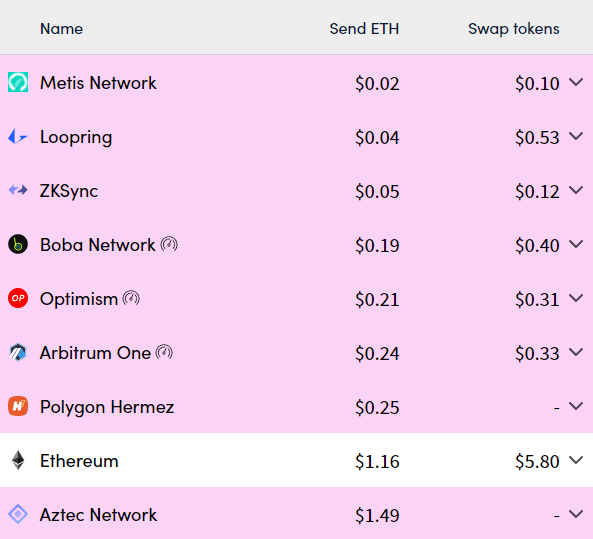
Under a tweet by Ryan Sean Adams (the “Bankless” podcast host) about the current fees on eight Layer 2 platforms. Vitalik Buterin left a comment in which he expressed his opinion that fees should be “under $0.05 to be truly acceptable.” Ryan Sean Adams took the data about fees from the L2 Fees website. It is worth noting that the data in the screenshot in the tweet is no longer relevant.
Needs to get under $0.05 to be truly acceptable imo. But we're definitely making great progress, and even proto-danksharding may be enough to get us there for a while!
— vitalik.eth (@VitalikButerin) May 3, 2022
Now (05.15) only Metis network with a transaction fee ETH of $0.02, ZKSync with a transaction fee ETH of $0.05 and Loopring with a transaction fee ETH of $0.04 are suitable for Vitalik’s requirements. But, the swap commission on these platforms starts from $0.10, $0.12 and $0.53, accordingly. (While I writing this, the data has already changed. See the current fees on l2fees.info)
Vitalik Buterin has long promoted the goal of significantly reducing fees on Layer 2. In an interview in 2017, Buterin said that “The Internet of Money should not cost 5 cents per transaction. It’s kind of absurd.”
In January of this year, Vitalik tweeted that he 100% agreed with his 2017 comment. “That was the goal in 2017, and it’s still the goal now. It’s precisely why we’re spending so much time working on scalability”.
4. Though I 100% stand by my comment that "the internet of money should not cost more than 5 cents per transaction". That was the goal in 2017, and it's still the goal now. It's precisely why we're spending so much time working on scalability.https://t.co/M326MtrlE0
— vitalik.eth (@VitalikButerin) January 1, 2022
Also, in a comment under the Ryan Sean Adams tweet, Vitalik mentioned “proto-danksharding”. What is it? I would like to explain it in a simpler way, but this is a rather complicated technical term, so the explanation will be long.
I’ll start in order. What is sharding? Sharding is the process of splitting a database horizontally to spread the load — it’s a common concept in computer science. In an Ethereum context, sharding will reduce network congestion and increase transactions per second by creating new chains, known as “shards”.
Let’s move on. What is Danksharding? Danksharding is the new sharding design proposed for Ethereum, which introduces some significant simplifications compared to previous designs. The main innovation introduced by Danksharding is the merged fee market: instead of there being a fixed number of shards that each have distinct blocks and distinct block proposers, in Danksharding there is only one proposer that chooses all transactions and all data that go into that slot.
And, finally, let’s get to the initial term. What is proto-danksharding? Proto-danksharding (aka. EIP-4844) is a proposal to implement most of the logic and “scaffolding” (eg. transaction formats, verification rules) that make up a full Danksharding spec, but not yet actually implementing any sharding. The main feature introduced by proto-danksharding is a new transaction type, which is called a blob-carrying transaction. A blob-carrying transaction is like a regular transaction, except it also carries an extra piece of data called a blob. Blobs are extremely large (~125 kB), and can be much cheaper than similar amounts of calldata.
It wasn’t easy, but I hope you understand everything. So, Vitalik Buterin believes that proto-danksharding will put downward pressure on Layer 2 fees.
“Because validators and clients still have to download full blob contents, data bandwidth in proto-danksharding is targeted to 1 MB per slot instead of the full 16 MB. There are, nevertheless, large scalability gains because this data is not competing with the gas usage of existing Ethereum transactions,” Vitalik wrote in his blog last month.

